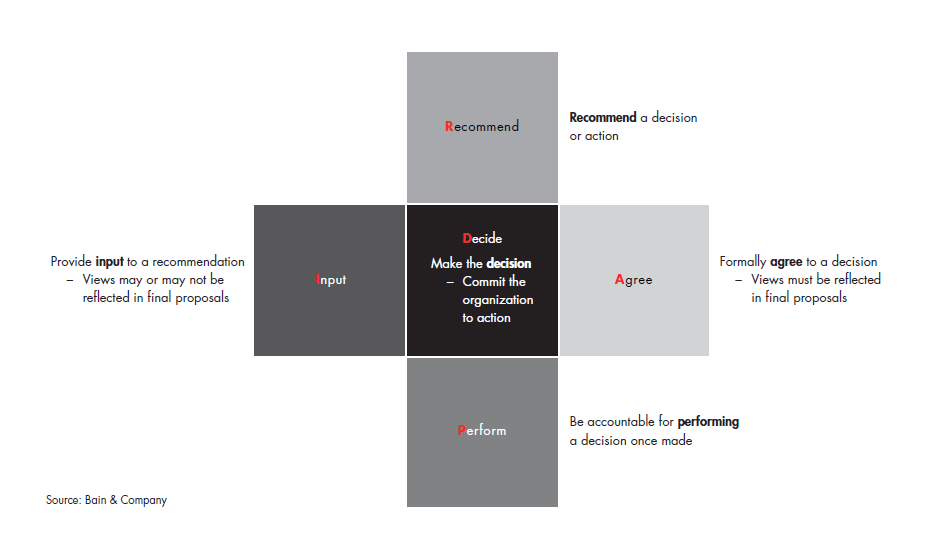Rapid Decision Making - The Bain Model
 Steve Romero Posted on
Steve Romero Posted on  Monday, January 20, 2020 at 6:11AM
Monday, January 20, 2020 at 6:11AM There are countless variations of IT governance but no matter the size or flavor, at its core, IT governance is about decision-making. Sound IT governance ensures an enterprise realizes the most value from information technology by providing the mechanisms capable of assuring optimal, reasoned and rational information technology decisions. There are two types of IT governance mechanisms, processes and relationships.
The majority of enterprises focus their IT governance efforts on the relationship dimension by assigning decision-making authority to governance bodies, mostly in the form of committees. I have encountered far too few organizations that realize they are implementing governance when an individual is assigned decision-making authority. I have found even fewer organizations that recognize they are implementing governance when they establish policies, standards, and formal processes. Recognized as governance or not, these common mechanisms play a significant role in decision-making due to their mandatory nature and the notion that personnel are subject to their authority.
Whether they are implemented as formal governance or simply under the guise of executive say-so, decision-making mechanisms don’t always ensure the best decisions because despite their recognized authority, they don’t necessarily assure the appropriate decision-making accountability. Many people subject to the decisions of an enterprise are not included in the decision-making process, or the establishment of the decision-making mechanisms. This exclusion results in many of the mechanisms being perceived as autocratic, bureaucratic, arbitrary, or just plain wrong. People are subject to the decision-making authority but they are not accountable for the decision.
Thoughtful solicitation and collection of the right input has long been recognized to produce the best business processes, policies, and standards. The same is true for decision-making bodies. The challenge is to correctly and optimally define the roles and responsibilities involved in the establishment and subsequent execution of decision-making mechanisms. This is not a simple undertaking.
I recently encountered an elegant option to the clarification of decision accountability roles and responsibilities when one of my clients asked me what I thought of Bain’s RAPID® model. I had never seen the model and I was surprised to find it was developed three years ago. I did a little research and I liked what I found. Though the approach was designed to address making individual decisions, I am convinced it could be useful in the design, implementation, and management of governance mechanisms.
According to Bain & Company, “High-quality decision making and strong performance go hand in hand. Yet, in many companies, even clear, well framed decisions can be derailed by uncertainty over roles and responsibilities.” To address this common problem, Bain created RAPID®, a tool to clarify decision accountability. R-A-P-I-D is a “loose” acronym for: Input; Recommend; Agree; Decide; and Perform. RAPID® assigns owners to these five key roles in any decision. “When the roles involved in decisions are clearly delineated, teams and organizations make the right choices—swiftly and effectively.”

I like Bain’s RAPID®model. I am a fan of just about ANY approach that makes decision-making accountability explicit and transparent. And therein lies the rub. Many enterprise cultures are averse to the ideas of explicit accountability and transparency. There is no place to hide. So first and foremost, the organization using the model needs to ensure the culture of the enterprise is conducive to functioning with clear, steadfast rules and total transparency. Executive sponsorship and mid-manager leadership is essential. (Believe it or not, the latter is more important than the former.)
And though I like the model and its acronym, I believe it has two inherent challenges:
1) It is RIRARDP, not RAPID. Everyone will remember the acronym, but they won’t necessarily remember each of the associated roles and responsibilities or their progression. As Bain admittedly notes, it is a “loose acronym”. I think their “loose” characterization refers to the fact that the sequence is not indicated in the acronym – otherwise it would be RIRARDP. Recommenders solicit input from the Inputers so they can Recommend to the Agreers to obtain the agreement necessary to Recommend to the Deciders who ensure the decision is Performed if it is indeed decided. Given this sequence, it is easy to see why BAIN chose the quite memorable but emblematic RAPID acronym.
2) The acronym may be RAPID, but I’m not convinced it will be “swift” as Bain claims because using the tool involves many people and interfaces. I believe in many cases it will slow existing decision-making cycle time, especially in the case of unilateral decision-making. The number of roles and level of participation creates multiple interactions and the potential for numerous consensus-driven adjustments. The upside is that decisions will ultimately be made and they are far more likely to succeed given their inclusive nature. To justify the additional time required to make inclusive decisions, I suggest this model should only be applied in an organization with a history of having trouble making decisions and/or one that frequently makes unsuccessful decisions.
Despite the challenges, Bain has produced a compelling model designed to foster inclusion and transparency in decision-making. It has the potential to produce incredible results, but only when it is applied appropriately. I think it would be a mistake for organizations to automatically or indiscriminately use it on each and every decision. They should start by using it on the most critical decisions – when they foresee barriers to those decisions being made, and/or being made well.
If you have used Bain’s RAPID® model I would love to hear about the experience and its results.
~ Steve ~


Reader Comments